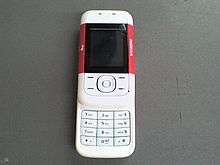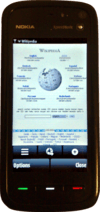XpressMusic
XpressMusic is a brand name for a line of Nokia phones that are specially designed for music playback. All of Nokia's XpressMusic come with expandable MicroSD memory slots, so these phones can also be used as MP3 players. The XpressMusic range of phones was launched to compete with the Walkman brand series of Sony Ericsson.
In September 2009, Nokia announced the X3-00 and X6. The new Xseries will replace the XpressMusic brand which has been applied to 5000 series models (except the first).
History
2006
The 2006 lineup consists of just one phone, the 3250. It has a unique form factor where the bottom part containing the keypad twists, exposing the camera on the side, and dedicated music controls on the reverse. The twisting action activates different modes in the software - music player for when the music controls are facing the user, or the photo/video recorder when the camera is facing either forward or to the user.
| Model | Announced date | Platform | Form factor | Screen | Networks | Memory card (max size) |
|---|---|---|---|---|---|---|
| 3250[1] | September 26, 2005 | S60 3rd Edition | Candybar (Keypad twists) |
176 × 208 (18-bit) |
GSM / (E)GPRS | MicroSD (2 GiB) |
2007

In 2007 Nokia added the almost identical 5200 and 5300 sliders. They later added the 5700, using a twisting keypad like the 3250. The 5200 was the only phone that was not branded XpressMusic at all.
| Model | Announced date | Platform | Form factor | Screen | Networks | Memory card (max size) |
|---|---|---|---|---|---|---|
| 5200[2] | September 27, 2006 | S40 3rd Ed., FP 2 | Slider | 128 × 160 (18-bit) |
GSM / (E)GPRS | MicroSD (2 GiB) |
| 5300[3] | September 27, 2006 | S40 3rd Ed., FP 2 | Slider | 240 × 320 (18-bit) |
GSM / (E)GPRS | MicroSD (2 GiB) |
| 5700[4] | March 29, 2007 | S60 3rd Ed., FP 1 | Candybar (Keypad twists) |
240 × 320 (24-bit) |
GSM / (E)GPRS | MicroSD (2 GiB) |
2008

The 2008 lineup saw the first 3G XpressMusic phones, first the 5610 and later the 5320, which included HSDPA. The lineup also added support for MicroSDHC, allowing cards larger than 2GiB.
| Model | Announced date | Platform | Form factor | Screen | Networks | Memory card (max size) |
|---|---|---|---|---|---|---|
| 5310[5] | August 29, 2007 | S40 5th Ed., FP 1 | Candybar | 240 × 320 (24-bit) |
GSM / (E)GPRS | MicroSDHC (2 GiB) |
| 5610[6] | August 29, 2007 | S40 5th Ed., FP 1 | Slider | 240 × 320 (24-bit) |
GSM / (E)GPRS; W-CDMA |
MicroSDHC (4 GiB) |
| 5220[7] | April 22, 2008 | S40 5th Ed., FP 1 | Candybar | 240 × 320 (18-bit) |
GSM / (E)GPRS | MicroSDHC (8 GiB) |
| 5320[8] | April 22, 2008 | S60 3rd Ed., FP 2 | Candybar | 240 × 320 (24-bit) |
GSM / (E)GPRS; W-CDMA / HSDPA |
MicroSDHC (16 GiB) |
2009

The 2009 lineup started with the 5800, one of two new phones (the other being the N97) to use the new touch-based S60 5th edition, likely designed as a response to the increasing popularity of Apple's iPhone. And apart from the 5130, the rest of the lineup are 3G phones running S60.
| Model | Announced date | Platform | Form factor | Input | Screen | Networks | Memory card (max size) |
|---|---|---|---|---|---|---|---|
| 5800[9] | October 2, 2008 | S60 5th Edition | Slate | Touch | 360 × 640 (24-bit) |
GSM / (E)GPRS; W-CDMA / HSDPA; Wi-Fi |
MicroSDHC (16 GiB) |
| 5130[10] | November 4, 2008 | S40 5th Ed., FP 1 | Candybar | Keypad | 240 × 320 (18-bit) |
GSM / (E)GPRS | MicroSDHC (16 GiB) |
| 5630[11] | February 10, 2009 | S60 3rd Ed., FP 2 | Candybar | Keypad | 240 × 320 (24-bit) |
GSM / (E)GPRS; W-CDMA / HSDPA / HSUPA; Wi-Fi |
MicroSDHC (16 GiB) |
| 5730[12] | March 11, 2009 | S60 3rd Ed., FP 2 | Candybar | Keypad, QWERTY keyboard |
240 × 320 (24-bit) |
GSM / (E)GPRS; W-CDMA / HSDPA / HSUPA; Wi-Fi |
MicroSDHC (32 GiB) |
| 5530[13] | June 15, 2009 | S60 5th Edition | Slate | Touch | 360 × 640 (24-bit) |
GSM / (E)GPRS; Wi-Fi |
MicroSDHC (16 GiB) |
See also
References
- ↑ "Device Details -- Nokia 3250". Nokia. Retrieved 2010-05-17.
- ↑ "Device Details -- Nokia 5200". Nokia. Retrieved 2010-05-17.
- ↑ "Device Details -- Nokia 5300 XpressMusic". Nokia. Retrieved 2010-05-17.
- ↑ "Device Details -- Nokia 5700 XpressMusic". Nokia. Archived from the original on August 3, 2009. Retrieved 2010-05-17.
- ↑ "Device Details -- Nokia 5310 XpressMusic". Nokia. Retrieved 2010-05-17.
- ↑ "Device Details -- Nokia 5610 XpressMusic". Nokia. Retrieved 2010-05-17.
- ↑ "Device Details -- Nokia 5220 XpressMusic". Nokia. Retrieved 2010-05-17.
- ↑ "Device Details -- Nokia 5320 XpressMusic". Nokia. Retrieved 2010-05-17.
- ↑ "Device Details -- Nokia 5800 XpressMusic". Nokia. Retrieved 2010-05-17.
- ↑ "Device Details -- Nokia 5130 XpressMusic". Nokia. Retrieved 2010-05-17.
- ↑ "Device Details -- Nokia 5630 XpressMusic". Nokia. Archived from the original on August 31, 2009. Retrieved 2010-05-17.
- ↑ "Device Details -- Nokia 5730 XpressMusic". Nokia. Retrieved 2010-05-17.
- ↑ "Device Details -- Nokia 5530 XpressMusic". Nokia. Retrieved 2010-05-17.